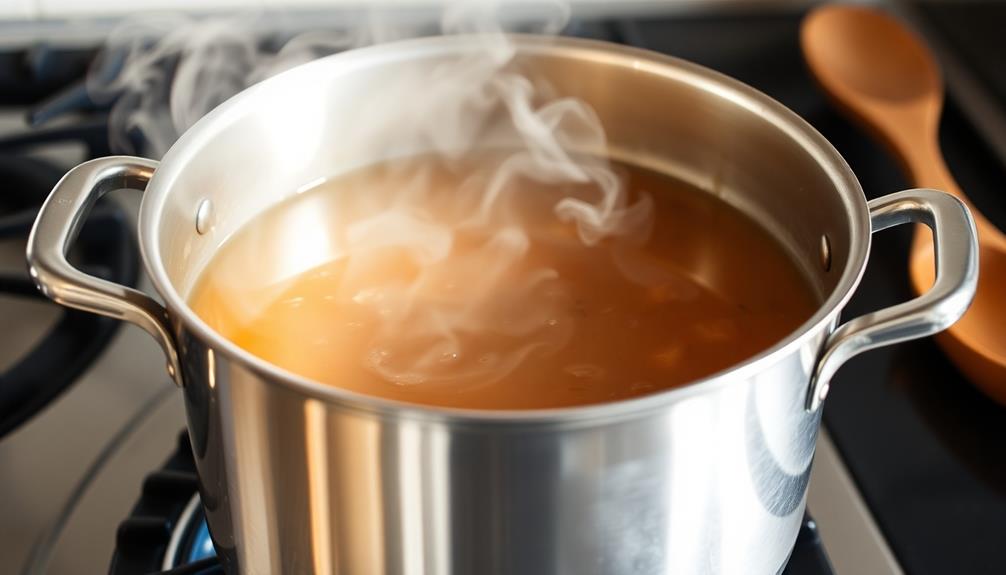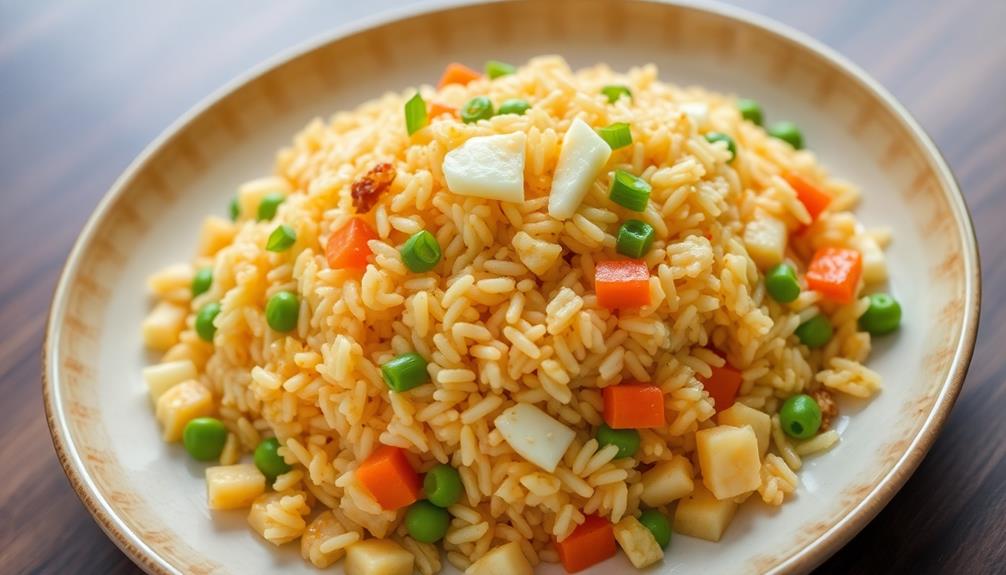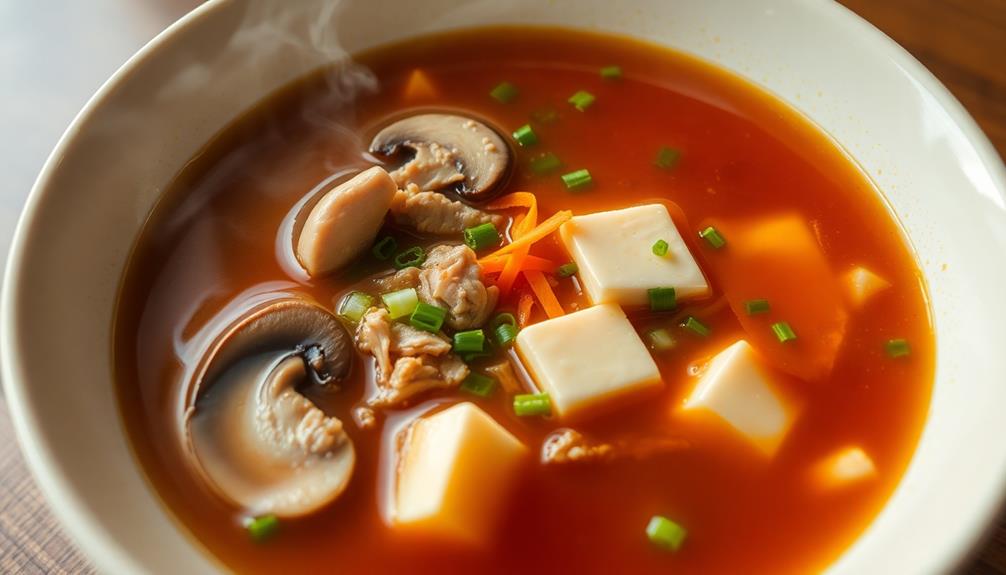Oh, you're in for a real treat! Lanzhou Beef Noodle Soup is a beloved regional specialty that's captivated palates for centuries. Its origins trace back to the Silk Road, where travelers and merchants blended cultures to create this aromatic masterpiece. The key is the slow-simmered beef broth, infused with spices like cinnamon and star anise. Then there are the hand-pulled noodles – so chewy and delightful! Top it all off with tender beef, fresh cilantro, and a kick of chili oil. It's a feast for the senses that'll have you coming back for more. And if you keep reading, you'll discover the secrets to making this comforting dish yourself!
Key Takeaways
- Lanzhou Beef Noodle Soup has its origins in the Silk Road era, reflecting cultural exchanges that influenced the recipe's evolution over centuries.
- The soup is a regional specialty and a source of local pride in Lanzhou, representing the culinary heritage of the region.
- The dish is made with key ingredients like slow-cooked beef, hand-pulled noodles, and a broth simmered with spices and aromatics.
- The cooking process involves soaking beef bones, boiling them, and adding spices to create a rich, flavorful broth.
- The soup is often enjoyed as a breakfast dish or late-night snack, and its popularity has spread globally with various adaptations.
History
It's widely believed that the origins of Lanzhou beef noodle soup can be traced back to the Silk Road era. During this time, travelers and merchants would stop in the city of Lanzhou, located in northwest China, to rest and refuel.
As they mingled with the local people, the recipe for this delicious dish slowly evolved, blending diverse cultures and flavors from across the ancient trade route.
Over the centuries, the people of Lanzhou perfected the art of making this beloved soup. They carefully selected high-quality beef, hand-pulled the noodles, and simmered the broth for hours to achieve the perfect balance of savory, fragrant, and comforting flavors.
Today, Lanzhou beef noodle soup is considered a beloved regional specialty, with its unique taste and preparation methods becoming a source of local pride and culinary tradition.
Recipe
Lanzhou beef noodle soup is a beloved dish from the city of Lanzhou in China's Gansu province. This hearty and flavorful soup features hand-pulled noodles, tender beef, and a rich, aromatic broth that has been simmered for hours to develop its deep, complex flavors.
The key to making an authentic Lanzhou beef noodle soup is in the careful preparation of each component. From the hand-pulled noodles to the slow-cooked beef, every step is crucial in creating the perfect balance of textures and tastes.
Ingredients:
- 1 lb beef brisket or chuck, cut into 1-inch cubes
- 1 onion, diced
- 3 cloves garlic, minced
- 2 inches ginger, peeled and sliced
- 2 star anise
- 2 cinnamon sticks
- 4 cups beef broth
- 2 tbsp soy sauce
- 1 tbsp rice vinegar
- 1 tsp Sichuan peppercorns
- 1 lb fresh hand-pulled noodles
- Chopped cilantro, for garnish
Instructions:
In a large pot, brown the beef cubes over high heat until they develop a nice sear on all sides. Remove the beef and set aside.
Add the onion, garlic, and ginger to the pot and sauté until fragrant, about 2-3 minutes. Return the beef to the pot, along with the star anise, cinnamon sticks, beef broth, soy sauce, rice vinegar, and Sichuan peppercorns.
Bring to a boil, then reduce heat and simmer for 2-3 hours, until the beef is fork-tender.
Extra Tips:
For the most authentic experience, use freshly made hand-pulled noodles. If you can't find them, you can substitute with fresh or dried Chinese egg noodles.
Additionally, feel free to adjust the seasonings to your taste, adding more soy sauce, vinegar, or Sichuan peppercorns to suit your preferences.
Garnish the soup with plenty of fresh cilantro for a bright, aromatic finish.
Cooking Steps
Soak the beef bones overnight to extract their rich flavor.
Next, boil the bones for 2 hours, then add fragrant spices and aromatic veggies.
Let the broth simmer for another hour, straining it to get a clear, flavorful base.
Step 1. Soak Beef Bones Overnight

Gathering the necessary components is the first step in crafting an authentic Lanzhou beef noodle soup. First up? Soaking the beef bones overnight.
You'll want to grab a large pot and fill it with cold water. Toss in those beefy bones and let 'em soak for 8 to 12 hours. This helps remove any impurities and gives the broth a richer, more intense flavor.
Once the bones have had their beauty sleep, it's time to drain the water and give 'em a good rinse. This ensures your broth will be crystal clear – no one wants a murky soup!
Grab a fresh pot, add the bones back in, and cover with water. Bring it all to a boil, then reduce the heat and let it simmer for 3 to 4 hours. During this time, the bones will release their gelatin, creating a wonderfully thick and velvety broth.
Get ready for some serious flavor!
Step 2. Boil Bones for 2 Hours

With the beef bones having soaked overnight, the next step is to boil them for a couple hours.
Grab a large pot and fill it up with fresh water, then toss in those beefy bones. Bring the pot to a boil over high heat, and once it's bubbling away, you'll want to reduce the heat to medium-low.
Now, let the bones simmer for 2 full hours, making sure to skim off any foam or impurities that rise to the surface. As the bones cook, you'll start to see a rich, golden broth developing – that's exactly what you want!
This slow simmering process helps extract all the delicious flavor and nutrients from the bones, creating a super flavorful foundation for your Lanzhou beef noodle soup.
Just be patient and let the pot do its thing for the next 120 minutes. Your taste buds will thank you later!
Step 3. Add Spices and Aromatics

Once the bones have simmered for two hours, it's time to infuse the broth with a blend of aromatic spices and herbs. First, add a few cinnamon sticks, some star anise, and a handful of Sichuan peppercorns. These ingredients will lend the soup a warm, subtly spicy flavor that's simply irresistible.
Don't forget the garlic and ginger too – they'll add a lovely fragrance and a little kick to the broth.
Next, toss in a bundle of green onions, sliced into 2-inch pieces. The onions will gently release their savory essence, complementing the other flavors beautifully. For a touch of freshness, add a few sprigs of cilantro. Their vibrant green color and bright, herbal notes will really make the soup shine.
Simmer this aromatic medley for about 30 minutes, allowing the spices to infuse the broth with their magnificent essence.
Get ready for your kitchen to be filled with the most tantalizing aroma – it's sure to get your taste buds tingling in anticipation!
Step 4. Simmer for 1 Hour

After infusing the broth with the aromatic spices and herbs, you'll want to let it simmer for an additional hour. This step is crucial for developing the rich, complex flavors that make Lanzhou beef noodle soup so irresistible.
As the pot bubbles away on the stovetop, the spices will continue to release their essence, filling your kitchen with a tantalizing aroma. Be sure to keep an eye on the pot, giving it an occasional stir to ensure the ingredients blend together seamlessly.
Don't be tempted to crank up the heat – slow and steady is the way to go here. After an hour of gentle simmering, you'll have a broth that's deep, savory, and oh-so-satisfying.
Now, it's time to add the tender beef and fresh noodles, transforming this culinary masterpiece into a dish that's worthy of the renowned Lanzhou noodle shops. Get ready to indulge in a bowl of pure comfort and flavor!
Step 5. Strain Broth, Add Cooked Noodles

Grab a fine-mesh strainer and carefully pour the fragrant broth through it, leaving behind the spent aromatics. This will give you a clear, golden liquid that's ready for the next step.
Now, grab your cooked noodles and gently place them into the strained broth. Ooh, can you smell that heavenly aroma? The tender beef and aromatic spices have infused the broth with so much flavor.
Give the noodles a gentle stir to make sure they're fully submerged. This'll allow them to soak up all that delicious beefy goodness.
Now, it's time to serve! Ladle the piping hot noodles and broth into your bowls. Top each portion with some of the reserved cooked beef, a sprinkle of fresh cilantro, and a squeeze of zesty lime juice. Mmm, doesn't that look absolutely scrumptious?
Get ready to dive in and enjoy the incredible taste of Lanzhou-style beef noodle soup!
Final Thoughts
In the end, Lanzhou beef noodle soup stands out as a culinary delight that showcases the harmonious blend of regional traditions and flavors. The rich, savory broth combined with hand-pulled noodles and tender slices of beef creates an unforgettable dining experience that both nourishes and satisfies. Unlike a southernstyle noodle soup recipe, which often highlights lighter broths and different flavor profiles, Lanzhou beef noodles emphasize depth and bold seasoning. Its delicate balance of spices and textures pays homage to centuries of culinary craftsmanship in northwest China.
The tender beef, the chewy noodles, and the savory broth come together in a symphony of tastes that'll have you coming back for more. You might've started your journey with a simple bowl, but by the time you're done, you'll feel like you've taken a delicious trip through the vibrant streets of Lanzhou.
The garnishes like cilantro, scallions, and chili oil add the perfect finishing touches, elevating the dish to new heights.
So, whether you're a seasoned foodie or just looking to try something new, Lanzhou beef noodle soup is a must-try that'll leave you satisfied and eager to explore more of this incredible regional cuisine.
Bon appétit!
Frequently Asked Questions
What Is the Origin of the Name "Lanzhou Beef Noodle Soup"?
You likely wonder about the origin of the name "Lanzhou Beef Noodle Soup." The dish is named after the city of Lanzhou, where it's believed to have originated, featuring the classic combination of tender beef and chewy noodles.
How Long Does It Take to Make Lanzhou Beef Noodle Soup?
Making this dish takes time and patience. Typically, it can take up to 4 hours to prepare the noodles, braise the beef, and bring all the flavors together. But the results are well worth the effort for a truly authentic and delicious dish.
Can Lanzhou Beef Noodle Soup Be Made With Different Types of Meat?
Yes, you can make this dish with different types of meat. While beef is the traditional choice, you can experiment with other proteins like pork, chicken, or even lamb to create your own unique flavor profile.
What Are the Health Benefits of Eating Lanzhou Beef Noodle Soup?
Eating a hearty soup like this can provide numerous health benefits. You'll get a boost of protein, vitamins, and minerals that can support your overall well-being. Plus, the warmth and nourishment will leave you feeling satisfied. For an added bonus, you can customize this recipe to include your favorite vegetables and spices, making it a versatile wonton soup recipe that you can enjoy time and time again. Whether you’re looking for a quick and easy weeknight meal or a comforting dish to warm you up on a chilly day, this soup is sure to hit the spot. Try adding some extra chili flakes for a spicy kick, or throw in some extra leafy greens for added nutrition. The options are endless when it comes to this delicious and nourishing soup.
How Can I Store Leftover Lanzhou Beef Noodle Soup?
To store leftover soup, let it cool completely before transferring to an airtight container. It'll keep in the fridge for 3-4 days or freeze for up to 3 months. Reheat gently when ready to enjoy.









